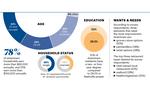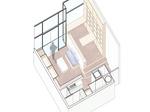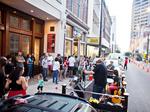Downtown Nashville has boomed in the past 20 years, fueled by the opening of major entertainment destinations like Bridgestone Arena and the Country Music Hall of Fame and Museum and an influx of new workers and full-time residents.
The population of downtown Nashville — defined by Jefferson Street to the north, the Cumberland River on the east and the interstate loop on the south and west — has soared 272 percent since 2000, outpacing Greater Nashville, where population has grown by 16 percent.
But for all of downtown’s success, there is one win still absent: landing a major retailer.
Soft-goods retailers — clothing, home goods and health and beauty items — are critical to creating a downtown that attracts employers and residents, tourists and locals.
Experts say that, despite the rapid growth, downtown Nashville still doesn’t have enough people or dedicated retail space to attract these types of stores, which are few and far between in the city’s urban center. But if Nashville is going to compete with cities like Portland, Austin and Charlotte for a young, educated workforce, it needs them — and soon.
A handful of new developments, including the old convention center site and high-rise apartments in SoBro, are expected to bring more residents downtown and open up ground-floor retail space.
But with rising rents, tight parking and pending city rules aimed at chain stores, will retailers follow? It could mean the difference between a downtown catered to tourists and the 8-to-5 office crowd, or an urban neighborhood for full-time residents.
The right kind of retail
More retailers are opening downtown than ever before, but it’s not necessarily what we need to attract and keep downtown residents.
“We have work down pat, we have play down pat, but in terms of living, it’s a little bit challenging,” said Austin Benedict, a commercial real estate broker for Colliers Nashville who leases space downtown. “And a lot of that has to do with the fact that existing retail is geared toward tourists.”
The Nashville Downtown Partnership hired a Seattle-based firm called Downtown Works in 2007 to help implement a retail strategy for the 90-square block area that makes up Nashville’s Business Improvement District. The plan focused on both local and national retailers. It identified downtown’s strengths — a growing arts scene, the state Capitol — and its challenges, including buildings designed exclusively for office use and too many passive spaces.
The plan included SoBro and the Gulch, but it encouraged the city to jumpstart downtown retail within the city center, an area defined from the riverfront up to Eighth Avenue.
According to the group’s 2013 annual report, the broader downtown district, including SoBro and the Gulch, had 190 dining options, 115 shopping options, 88 nightlife venues and 23 galleries.
As of June of this year, those areas had 35 new retail openings, on pace to surpass last year’s total of 49.
But not all retail is created equal. Most of what’s opening downtown are stores catered to either tourists or daytime office workers. All but eight of those openings this year have been food and beverage related. In comparison, one salon — Rodney Mitchell Style Bar and Salon — and one big-brand clothing store — Loft by Ann Taylor — have opened.
In a recent survey by the Downtown Partnership, downtown residents said an urban grocery store, a movie theater and more shopping topped their list of wants for yet another year. Popular lunchtime spots, including Oscar’s Taco Shop and the Jimmy John’s on Church Street, close in the early evening at 6 p.m. and 7 p.m., respectively, leaving many residents without walkable options for quick, casual, wallet-friendly dining options.
Frothy Monkey, the popular local coffee shop chain, opened a downtown location in May on Fifth Avenue, across the street from the downtown Arcade. Owner Ryan Pruitt said he had been eying the downtown market because of the aggressive residential growth, noting that he had 60 households on either side of the restaurant.
“Frothy is a neighborhood concept. … This is the most neighborhoody place in downtown,” said Pruitt, pointing to the Fifth Avenue art district’s recently upgraded streetscape, his art gallery neighbors and the daytime foot traffic from office workers.
But one is a lonely number. He hopes more local, casual restaurants will follow suit, viewing them not as competition, but as more enticement to get customers into the neighorhood. The downtown location is the first Frothy Monkey to have a full bar, which Pruitt hopes will attract nearby residents not wanting to deal with the hassle of packed honky-tonks on Lower Broadway.
Tourists vs. locals
The recent debate over a potential Walgreens on Lower Broadway highlights the tug-of-war between protecting downtown Nashville as a tourism destination and developing it as a residential hot spot.
Tourism officials argued that opening a Walgreens (or any other large, national chain) on Lower Broad, next to honky-tonks, would dilute the unique Nashville experience.
An ordinance introduced to Metro Council in May sought to keep chain retailers out of downtown’s most popular tourism district, a 17-acre area that covered Second Avenue North, Lower Broadway and Printers Alley.
The ordinance was deferred indefinitely, but some have said it caused enough of a hold-up to kill the Walgreens deal. And the issue is far from dead.
Richard Jones, a commercial real estate broker who represented Walgreens, said the legislation wouldn’t help the city’s push to get residents and retailers downtown.
“If you want people to live downtown, they have to have good services. They can’t be going to honky-tonks every night,” he told the Nashville Business Journal in May.
The Nashville Convention and Visitors Corp., which supported the original ordinance, already is drafting a new retail proposal.
“We still believe there is a rational solution to protecting our authenticity and not being overly onerous to business development,” said Butch Spyridon, president and CEO of the visitors corporation.
Spyridon wouldn’t talk details yet about his group’s proposal, but he anticipates it will cover a similar geographic range. He hopes to have something to show Metro, tourism players and developers in the next 60 days.
Spyridon said tourism and residential uses can coexist downtown, but in the right locations.
“It’s not just what you have, it’s where you have it. … You kind of have to know what’s in your neighborhood before you buy,” he said. “If you’re buying downtown, I think you’re subscribing to the energy and excitement that comes with living in a downtown core.”
What retailers want
But in other cities, that energy and excitement also means retail.
When the Swedish clothing giant H&M opened its first Portland, Ore., store in 2010, it did so in the heart of downtown at the Pioneer Square shopping center. In comparison, H&M’s first Nashville store, which opened last year, did so at Opry Mills, the sprawling suburban shopping center 10 miles outside downtown.
“The reason [downtown retail] has never evolved in my opinion is because you’ve never had a large enough mass of retailers,” said Elliott Kyle, a Nashville-based retail site selector with Philadelphia-based McDevitt Co. Kyle works with retailers across the Southeast, including recruiting higher-end tenants like Calypso to Hill Center in Green Hills.
“There are a handful of smaller, niche retailers. Most of your national, soft-goods retailers, they want to surround themselves with other soft-goods retailers,” Kyle said.
He’s hopeful that new, mixed-use urban projects will turn the tide for retail in downtown Nashville, especially as its population and household income continue to climb.
“There are some projects that I’m aware of south of Eighth Avenue that will open that critical mass. It may not open flood gates immediately, but over time as that permanent, residential population solidifies … downtown’s retail will evolve,” Kyle said.
A shifting face of retail also works in downtown’s favor.
Jesse Tron, a spokesman for the International Council of Shopping Centers, said retailers are increasingly going the way of City Target, meaning they are looking at nontraditional floor plans and changing their inventory, even opening small pop-up shops, store-in-stores and vending machines.
“Format size is changing across the board,” Tron said. “Ten, 15 years ago, retailers really put themselves in a box to what space requirements were. They would always stick to that model. I think you are seeing a willingness from retailers to adapt to all formats in this country.”
Wanted: Even more residents
But even if space comes online, downtown Nashville needs more residents to make a strong economic case for mass retailers.
Nashville’s downtown resident growth has been notable, with a bumper crop of new apartments and condos. Yet the city still lags peer cities like Charlotte and Austin in numbers of downtown residents and amenities. In many ways, that’s a lingering symptom of being late to the game.
Nashville didn’t change its code to allow downtown living until the 1990s, and it wasn’t until 2010 that the Downtown Code passed, which eased variances and made it cheaper and easier for developers to build residential projects downtown.
“There’s still an ongoing demand for housing,” said Rick Bernhardt, executive director of the Metro Planning Department. “Partly because we didn’t have much housing to begin with. We are still having to build in response to that demand.”
The numbers back him up. For the third-straight year, rental occupancy is hovering around 98 percent, slowing downtown’s population growth to an estimated 6 percent this year, down from 15 percent last year. There’s a two-month supply of units on the condo market, tighter than the three-month supply at this time last year.
In total, downtown Nashville is expected to finish 2014 with 7,685 residents and 4,803 units. By the end of 2015, both downtown residents and housing stock are expected to grow an additional 5.5 percent in Nashville.
In comparison, downtown Austin, where occupancy is 89 percent, is expected to grow its housing stock by 28 percent during that same time period. Downtown Charlotte, which has a 93.8 percent occupancy rate, is expected to increase its housing by 17 percent.
Even if all planned units come online by 2017, the Downtown Partnership predicts a 900-unit deficit in downtown Nashville.
“Based on what we are building now and that we are at capacity on rentals right now, demand is still outpacing supply,” said Tom Turner, CEO of the Nashville Downtown Partnership. “So are we there yet? As long as demand outpaces supply, I’d have to say no.”


